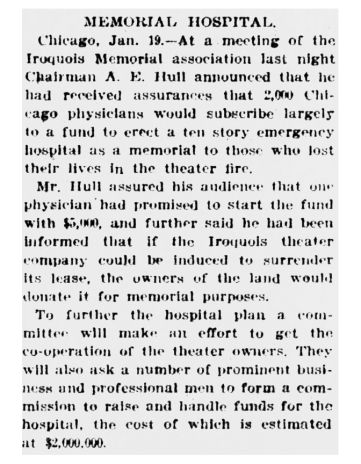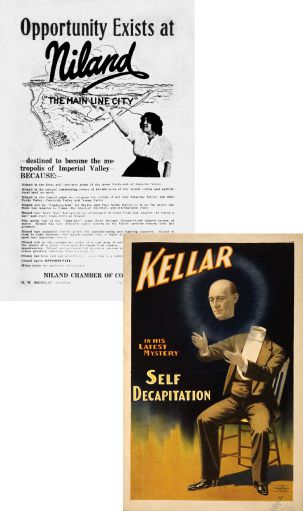|
The smoke had barely cleared at the Iroquois when husband and father, Arthur E. Hull became an
outspoken crusader for justice, co-founding the
Iroquois
Memorial Association and pressing for conviction of those responsible. (More
about Arthur below.)
Dwight and Donald were the sons of Arthur's older
brother, the late John Frederick Hull (1866-1900) of Topeka, Kansas. They had been adopted just three
weeks before the fire, their mother, Della Mae Stout
Hull, having died the previous March.
Marion Hull was survived by her parents, Howard and
Phoebe Morey Kelsey, and her two sisters, Carrie
Kelsey Simmons and Helen Kelsey Pond, all of New
York.
Arthur Hull learned of the Iroquois fire around 5:00
pm that afternoon. His search for his wife and
children started at the temporary medical center set
up at J. R. Thompson's restaurant next to the
theater and lasted until around midnight when most
morgues closed their doors on the 30th so that
bodies, possessions, and paperwork could be
organized.
|
 |
The next morning, Hull contacted his pastor,
Methodist Episcopal minister James Henry MacDonald (1865–1938),† who organized a large
search party, reportedly with fifty people, to
revisit the seventeen morgues and hospitals housing
Iroquois victims.
Marion and Dwight's bodies were found on Wednesday
among 278 victims at Jordan's funeral home and Helen
and Donald's among 66 at Gavin's funeral home two
days later. Mary Forbes' body was found and
identified on January 4th.
A funeral for the Hull family was held at Boydston Brother's funeral home on 42nd Place and Cottage Grove Ave, the service conducted by Reverend MacDonald). A poem found
in Marion's desk was read during the service. The
caskets were then transported to the 39th street
railway depot and shipped via Michigan Central
Railway to Troy, NY, for burial in the East
Greenbush Cemetery in East Greenbush, New York.
All three Hull children had attended the Oakland
school. A teacher at the school,
Millie
Crocker, was also an Iroquois Theater fire victim.
|
|
Arthur E. Hulll (1867–1944)
Became a prominent part of the post-fire story and went on to lead an interesting life.
In the first week after the Iroquois fire, Hull
filed a manslaughter suit against
Iroquois owners Will J. Davis and Harry Powers, along
with building commissioner Williams, and co-founded the
Iroquois Memorial Association.
Through his attorney,
Thomas D. Knight, he dropped the manslaughter suit a week after it was
drawn, announcing they were satisfied the coroner's
inquest and grand jury& processes
would properly prosecute the offenders. That
satisfaction lasted two weeks, ending when the
coroner jury's findings about Chicago's
democrat mayor were in essence overturned with a writ of habeas corpus,
and the prosecutor and judge publicly opined that
charges against the mayor were likely insufficient
to prosecute.
By then, Hull had bonded with Chicago's Republican
newspaper, the Inter Ocean wanted
the mayor's head on a pike, and Hull wanted the
deep-pocketed Iroquois co-owners/Mr.
Bluebeard producers, Klaw & Erlanger, to pay big. With the fanning
his fury, Hull launched a campaign of condemnation,
asserting conflict of interest with two of the grand
jurors —
Philip Sharkey because
he had contracts with the city and
Ernst Heldmaier because as a subcontractor of Fuller Construction his
company had laid stonework in front of the Iroquois.
When the prosecutor and other attorneys made clear
there was insufficient cause to remove Sharkey and
Heldmaier from the grand jury, and the other jurors
issued a statement of confidence in Sharkey and
Heldmaier, Hull began to insist there'd been a gas
explosion during the Iroquois fire as a result of
flammable chemicals brought to the fire by the Mr.
Bluebeard company. Hull began to seem desperate.
 On Jan 18, 1904, he claimed that 2,000 physicians
would donate money for a large hospital and that if
the Iroquois corporation agreed to end its lease to
the property, the owners would agree to then sell it
to the Iroquois Memorial Association for the purpose
of erecting a $2 million hospital. It was the day
before the association's officers were to be
elected. If he hoped a relationship with the
landowners would win the presidency for him, he was
mistaken. The 2,000 physicians disappeared along
with his control of the association.
On Jan 18, 1904, he claimed that 2,000 physicians
would donate money for a large hospital and that if
the Iroquois corporation agreed to end its lease to
the property, the owners would agree to then sell it
to the Iroquois Memorial Association for the purpose
of erecting a $2 million hospital. It was the day
before the association's officers were to be
elected. If he hoped a relationship with the
landowners would win the presidency for him, he was
mistaken. The 2,000 physicians disappeared along
with his control of the association.
Hull persuaded Andrew W. Jefferis
Charles M. Bickford, and
John L. McKenna to join him in hiring investigators to collect evidence
and talked of hiring an attorney to sift through it
and submit it to the grand jury.
Instead of waiting for that evidence, or maybe
because it wasn't forthcoming, or perhaps because
Jefferis, Bickford, and McKenna weren't impressed
with what was found, Hull became convinced there was
a conspiracy. He produced a flyer claiming,
"powerful influences are at work to prevent the
punishment of those responsible." At the same time, hammered
incessantly about Chicago's evil mayor and crooked
grand jury proceeding, possibly giving Hull the
sense that he had strong supporters when in truth,
the comparative silence about Hull's accusations
from the city's leading newspaper, the Chicago
Tribune, should have been telling. Hull announced he was
giving up his business activities to focus full time
on punishing those who caused the Iroquois fire.
The clamor went on until February 13, 1904, when the
grand jury demanded a kind of courtroom showdown.
They subpoenaed Hull to explain and substantiate his
accusations. After a closed-door meeting between
Hull and assistant state attorney
Barnes,
Hull was questioned by the grand jurors. At last,
Hull admitted he could produce no evidence
demonstrating that Sharkey or Heldmaier's were
biased, no evidence of an explosion, no evidence of
a conspiracy. It was over.
|
 |
The grand jury's vote to indict Davis, Noonan,
Cummings, Williams, and Laughlin/Loughlin was
announced on February 20, 1904, followed by a
detailed report three days later explaining their
verdict.
Hull resigned from his position as first vice
president of the Iroquois Memorial Association on
February 24, announcing that he was headed first to
Kansas City, then to California, and might not
return to Chicago.
Perhaps hoping to find other victims willing to mix
politics and grief, the Inter Ocean ran
a story seemingly geared to drive a wedge between
members of the Iroquois Memorial Association. IMA
didn't bite, announcing it would continue with its
primary goals: erecting a memorial to Iroquois fire
victims and raising monies to assist destitute
families of victims.
Did Hull have a hand but played it poorly? Was he
bluffing? Was he manipulated by the Inter Ocean?
I doubt the answers will ever be known for sure.
Hull did return to Chicago, or remained there, for
at least eleven months, at which time he married
Emma Louise Firmenich (1862–1941), daughter of
wealthy starch producer, Dr. Joseph Firmenich, who
had died a couple of months before the Iroquois
Theater fire. Firmenich was a homeopath who made his
fortune in Buffalo, NY and relocated his family to
Chicago later in his life.
Though Hull had described himself as an attorney while
living in Chicago, operating as the president of the
J.P. Wood Claim and Adjustment Company (business
unknown, sounds like insurance), I found no evidence
of his attending law school, and he hired an
attorney to assist in filing a warrant relative to
the Iroquois Theater. I did, however, come across an
1899 blurb in his hometown Kansas City newspaper
about his being in town for a visit, boasting of his
half-million-dollar worth earned in real estate in
Denver and Chicago. No mention there of his being a
lawyer.
Hull was a man of great energy and ambition. Some highlights of his life:
1888 — believed to have been released from a 5-yr term in U.S. Navy
1906 — motored in Yosemite with 2nd wife and
friends
1910 — pallbearer with his partner W. H. Cline for Eva Kellar, widow and stage assistant of
legendary magician, Harry Kellar
1911 — sold oil land in Oxnard, CA, losing partner Cline and in San Francisco, again
claiming to be an attorney
1912 sold land in Victor Valley, California that
would eventually become Victorville, where he
became the first president of the chamber of
commerce
1913 negotiated the $2 million purchase of
47,000 acres of land in Imperial Valley,
California
1914 named town of Niland, California in
Imperial County.
1920 living in Los Angeles, working as a
realtor
1944 — His obituary claimed he was an
"archeologist of note" and had made "several
important discoveries in the Valley of the
Nile." I was able to verify most claims in his
obituary, but neither of those. Might be that
was as much a stretch as the claim that he was
an attorney. In his 1920's real estate
advertising, Hull demonstrates a love for
superlatives. Biggest, best, largest, most,
greatest, etc. He wouldn't have been the first
high-powered salesman with a penchant for
gilding the lily.
Notably, his obituary
omitted mention of Marion, Helen, Dwight, and
Donald.

|
